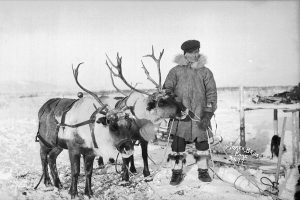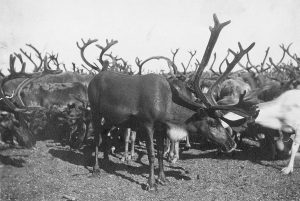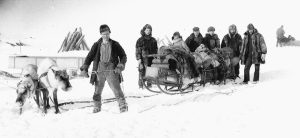The Great Trek – Being The Herding of 3,000 Reindeer From Frozen Alaska to The Canadian Tundra by The Arctic Moses.
Marlene Wisuri
Most of us are familiar with the mythical journey around the world that Santa Claus and his eight tiny reindeer take every Christmas Eve. But very few have heard of the actual five year trek led by the “Arctic Moses” from the wilds of Alaska to the tundra of Canada of over 3,000 reindeer. Anders (Andrew, Andy) Bahr was born in 1874 in Kautokeino/Guovdageaidnu, Norway, into a Sami reindeer herding family. As a young man in 1898, he was hired by the U.S. government to be a part of the Alaska Reindeer Project. The project had begun in 1891 when a few hundred Siberian reindeer were brought to Alaska as breeding stock along with four hired Chukchi trainers from the Chukotka peninsula. These reindeer would provide original stock for the Alaska Reindeer Project. Although the Chukchi herders soon returned home after conflicts with the Native Alaskans, the project continued under the supervision of Reverend Sheldon Jackson, the Alaska General Agent of Education and a Presbyterian minister. In 1894 and 1898, groups of Sami reindeer herders, their families, and dogs were hired and brought from Norway with the goal of teaching reindeer husbandry to Native Yupik and Inupiat volunteer apprentices during a time of food insecurity. Andy Bahr became a skilled herder and was recognized as one of the best.

The story of the Reindeer Project is a complicated one with many parts full of action, drama, and the melding of people and cultures. Reindeer herds and stations were set up at ten locations in western Alaska. Reindeer provided food and clothing for Alaska Native villagers, and food for others after the Nome gold rush began in 1899. The deer also hauled mining and building equipment and delivered mail. Native and Sami owned herds flourished. By the late 1920s herd populations had grown to over 500,000 and reindeer had also become a commercial enterprise largely due to the business acumen of a family of Norwegian descent from St. Paul, Minnesota. The Lomens had come to Alaska beginning in 1900 and were involved in several businesses including reindeer. Carl Lomen became known as the “Reindeer King” after purchasing herds from Sami and Alaska Natives. His herds grew and his business sold reindeer meat and other reindeer products throughout the U.S. Lomen promoted his wares somewhat ironically through Santa Claus and reindeer appearances in Christmas parades all over the lower 48 in the 1920s and 30s.
In 1925, the Canadian government began looking at the Alaskan project and concluded that a similar effort in Canada might help solve problems of hunger among the Inuvialuit population in Northwest Territories. Caribou herds that had traditionally been depended on for food and hides were diminished and Native population was becoming more settled near government outposts due to various colonization policies. So in 1929, the government purchased a herd of over 3,000 reindeer from the Lomen Company to be delivered across a trail above the Arctic Circle stretching over 1,500 miles from Naboktoolik, Alaska, to Kittigazuit on the Mackenzie River Delta. It was estimated the trip would take from 18 months to two years. The Lomens in turn hired Andy Bahr to be the leader of the expedition. The contract for the herd and its transport was $225,000 to be paid $30,000 down in August 1929, $82,000 to be paid a year later, with the remainder paid upon delivery of the reindeer.
Bahr came out of a comfortable retirement in Seattle and selected a team of five Sami herders, five Inupiat herders, a physician, and a dog musher to lead the migration. Nothing like the planned trek had ever been attempted before. An impressive amount of gear needed to be assembled including 40 pack sleds, weather appropriate clothing and footwear, skis, snowshoes, tents, “Yukon” stoves, lanterns, guns, compasses, and on and on. Also, a vital part of the crew were the herding dogs and sled dogs along with their food and harnesses. Food for the crew was both packed along and cached along the route via dog sleds, trade ships, and airplanes.
Assembled for the trip was a herd of 3,442 young reindeer with about ten females to each bull. The herd would be in flux throughout the trip with calves replacing deer lost en route as it went along. This vast rumbling, reindeer grunting mass set out on December 26, 1929, with the thermometer registering -30º F.

From the outset, the trip was beset with difficulties, delays, and downright disasters. The reindeer needed to travel during the winter months facing into the wind, which was often accompanied by howling blizzards and frigid temperatures that tested both men and beasts. The route was lined with predators waiting and willing to pick off calves and wandering or sick deer. Packs of hungry wolves tagged along and were a serious threat to the travelers. Bears, eagles, wolverines, and lynx also took a toll on the herd. And wintertime is dark making it difficult to see the herd or predators and other herders. The trek was brought to a halt each summer as calves were born and nurtured until they were strong enough to travel in fall and winter. Summer brought its own miseries in the form of warm, even hot, temperatures. But the worst plague of the summer were the hordes of insects that attacked the reindeer and the herders unmercifully– mosquitoes, warble flies, and nostril flies made the trip almost unbearable.
The favorite food of reindeer is reindeer lichen, which they dig out of the snow during winter. Summer feed is often green grasses and other vegetation and berries. Finding adequate supplies of food was a constant pressure and determined the routes taken by the herd and the health of the animals.
Another serious issue was the stampedes of the reindeer that occurred when the deer were spooked by predators, weather conditions, or encounters with other reindeer or wild caribou. Major stampedes in 1931 and 1933 with an almost catastrophic one in 1934 were in part responsible for the migration stretching out from the originally planned two years on the trail to almost five years. After a stampede the herders were forced to backtrack and round up the wayward deer before they could proceed again. Changes in project personnel occurred along the way as some herders left the trek and others were hired. Tensions ebbed and flowed, often triggered by bad food, bad weather, and personal grudges. Toward the end of the drive, all of the Sami herders had left and only Alaska Native herders remained. The families of Inupiat herders, brothers Peter and Tommy Wood, had joined them on the trail at the end of September 1931. A baby girl, Helen, was born to Peter and his wife the next June. Unfortunately, Helen passed away on the trail and was buried in the snow; the only loss of human life on the trek. Herd and herders persisted over mountain ranges, rivers, islands, and swamps which were all a part of the challenging topography of the route.
In spite of all of obstacles, Andy Bahr remained steadfast and trudged on.
Meanwhile as the herd made its glacial way across the northern landscape the Canadian government was preparing a settlement and grazing areas at the designated destination in the Mackenzie River Delta in Northwest Territory. In the 1932, three Sami herders and their families from Kautokeino/Guovdageaidnu, Norway, were hired by the Canadian government to supervise the herd once it arrived at its destination. Mathis Haetta, Aslak Torensis, and Mikkel Pulk joined Andy Bahr and provided reinforcements on the trail since they were just waiting in Kiitigazuit for the reindeer to arrive. A new town called Reindeer Station was built near the original stopping point. This is where the “Canadian Sami” were to live and oversee the herd while training Inupiat apprentices to take over.
Finally, on March 6, 1936, Andrew Bahr and his herders funneled 2,370 excited reindeer into the pens at Kiitigazuit to end a most amazing venture of almost five years. There were 1,498 females in the group and 811 fawns were born later that spring. Only about 20% of the herd were reindeer that had actually started out on the trek in 1929. Many reindeer had been lost on the trail and had been replaced by the births of fawns. Lomen Company was paid the remaining $146,000 for 2,300 reindeer. Andy Bahr returned to a hero’s welcome in Seattle where “Andy Bahr Day” was declared and he was dubbed the “Arctic Moses.” Although he had lost his real estate investments while he was gone due the Great Depression of the 1930s, he claimed to be happy to have just received U.S. citizenship. He lived another ten years until his death in Seattle in 1945. He is buried in Poulsbo, Washington, where a number of the original Alaska Sami and their descendants had settled.
The Great Trek had captured the imagination of people all over the U.S. and Canada, although accurate and timely communication was difficult because of the remote geography. In spite of the difficulties of getting news from the Arctic, at least fifteen feature articles were published in Minneapolis newspapers during the trek. Interest in Minnesota was perhaps spurred by the Loman connection. Two comprehensive books have been published, The Great Trek: The Story of the Five-year Drive of a Reindeer Herd Through the Icy Wastes of Alaska and Northwestern Canada by Max Miller in 1936 and Arctic Exodus: The Last Great Trail Drive by Dick North in 1991. A hard-to-find full length documentary movie The Herd was released by Peter Lynch in 1998 with First Nations actor, Graham Greene, providing the voice of Andrew Bahr.
Since 1935, the Canadian herd has had its ups and downs, but remnants of the original herd reside in Northwest Territories near Inuvik and are now owned by the Inuvialuit Regional Corporation there. Although the project never gained its dreamed of potential, the reindeer industry makes a substantial contribution to the Canadian economy including the tourist industry as hardy visitors are taken to witness the herd’s annual internal migrations.
A valiant story of men, the arctic, and animals – this is surely one of the great migration stories of the 20th Century!

